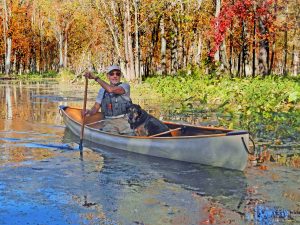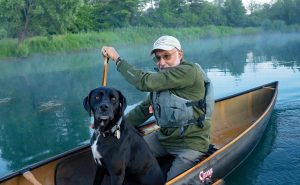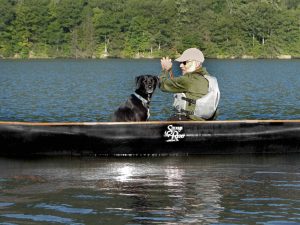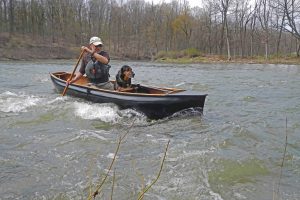by Marc Ornstein
We’ve all heard the stories. I took my dog paddling with me. He/she was jumping all over the place. I couldn’t control the canoe. We finally dumped… There must be a better way.
First: Are you completely comfortable with your paddling skills? Any deficiencies or lack of control will only be magnified with your furry friend aboard.
 Second: Know your dog. Does he or she have the proper temperament and ability/willingness to obey basic commands? If your dog won’t mind his manners on land, the problems will only be worse on the water. Is he comfortable around the water and able to swim? Obedience training is best done on firm ground and a dog that’s uncomfortable around water is likely to be nervous and unwilling to settle down.
Second: Know your dog. Does he or she have the proper temperament and ability/willingness to obey basic commands? If your dog won’t mind his manners on land, the problems will only be worse on the water. Is he comfortable around the water and able to swim? Obedience training is best done on firm ground and a dog that’s uncomfortable around water is likely to be nervous and unwilling to settle down.
How large and heavy is your dog? A miniature poodle may not have much effect on your boat trim but an 80# Labrador Retriever will require some adjustments.
By the time I adopted Racal, I’d had some experience (good and bad) paddling with my furry friends. My previous dog, Max, was hopeless in his early years. He calmed when older and became a great canoeing companion.
Rascal came from a shelter. He was 8 months old, rambunctious, and apparently, had never had any sort of training. His 1st day at home it became apparent that he had already bonded with me. I could walk him around the property, without a leash without fear of him running off. He was and still is very food motivated. He’d do most anything asked if he thought there was a treat to be had. By the end of day one, we had most of the basic commands down, and an empty cookie jar.
 The following morning, I decided to try him in the canoe. I took him down to the pond and had him sit on the dock while I placed the canoe in the water. I got into the boat while constantly repeating stay. He looked a bit puzzled but remained sitting on the dock. Once I was kneeling in the canoe, I said OK and tapped on the bottom of the boat, right in front of my knees. He leaned over the edge of the dock but wouldn’t enter the canoe until I placed a biscuit on the floor and tapped again. This time he dropped into the canoe as if he’d done it a thousand times before. He barely rocked the boat. I had him sit, praised him profusely, gave him a second biscuit and pushed off. I paddled once or twice around the pond while reminding him a few times to stay seated. As we approached the dock, I again reminded him to stay seated. Once settled at the dock, I reached over to the dock, tapped on it, and said out. He jumped out almost as gently as he had gotten in. More praise, cookies etc. I remained in the canoe and had him reenter as he had done the 1st time. This time he didn’t need to be coaxed by a cookie on the floor. I rewarded him, after he was aboard. We repeated this drill many times that day and the following days each time adding little twists to the game, including having him sit or lay on the dock while I paddled around the pond without him. We went through a lot of biscuits.
The following morning, I decided to try him in the canoe. I took him down to the pond and had him sit on the dock while I placed the canoe in the water. I got into the boat while constantly repeating stay. He looked a bit puzzled but remained sitting on the dock. Once I was kneeling in the canoe, I said OK and tapped on the bottom of the boat, right in front of my knees. He leaned over the edge of the dock but wouldn’t enter the canoe until I placed a biscuit on the floor and tapped again. This time he dropped into the canoe as if he’d done it a thousand times before. He barely rocked the boat. I had him sit, praised him profusely, gave him a second biscuit and pushed off. I paddled once or twice around the pond while reminding him a few times to stay seated. As we approached the dock, I again reminded him to stay seated. Once settled at the dock, I reached over to the dock, tapped on it, and said out. He jumped out almost as gently as he had gotten in. More praise, cookies etc. I remained in the canoe and had him reenter as he had done the 1st time. This time he didn’t need to be coaxed by a cookie on the floor. I rewarded him, after he was aboard. We repeated this drill many times that day and the following days each time adding little twists to the game, including having him sit or lay on the dock while I paddled around the pond without him. We went through a lot of biscuits.
The following weekend I had a scouting trip planned on the little stream which drains from Jones Pond to Osgood Pond in the Adirondacks, near Paul Smiths. I was meeting two good friends there and I knew they would be good sports, and enjoy meeting my new pup. We had to launch near the road so I employed their assistance until I had him aboard. Within a couple of hundred yards, we came upon the 1st of five or six beaver dams which required lift overs. Not knowing quite what to expect, I pulled up alongside the 1st one and tapped on it as if it were the dock at my pond. Rascal jumped right out, on to it and stayed while I got out and lifted the canoe over. I told him to stay (he seemed a bit nervous) and he did while I reentered. All it took was an “OK” and he popped right in. We repeated this game four or five more times on the way to Jones Pond and then again on the way back. Rascal was/is a quick learner. I still carry biscuits with me on every foray, whether it be a walk around the block or a day in the canoe as a training exercise.
Consider where in the world you’ll be paddling. We recently relocated to Florida. Any body of fresh water in Florida and in much of the south is potential Alligator habitat. While gators generally leave human adults alone (yes, we’ve all heard of exceptions) the same cannot be said of dogs. Rascal stays home when I paddle down here. I routinely see folks paddling canoes (and kayaks) with their dogs, often on rivers known to be inhabited by gators. I think it is reckless.
A bit about equipment:
Your canoe must be capable of safely and comfortably carrying the load, which now includes you, your dog, and your gear. You might want to start training in a larger, more stable canoe than you usually paddle. If the canoe isn’t stable, your dog will sense that and it will be all downhill from there.
 You’ll need to maintain proper trim. This presents some challenges if soloing with a dedicated solo canoe, not so much with a tandem. In a tandem, with a second paddler, keep the dog just forward of the stern paddler where the stern paddler can see what fuzzy is up to and calm him if necessary. Balancing the weight can be easily accomplished by moving around daypacks and other gear. In a dedicated solo canoe, the dog must be right in front of you (and behind the forward thwart), where you can maintain control of him. The added weight of your dog (Rascal weighs just over 70#s) will cause you to be bow heavy, and the canoe difficult to control. With a small dog, a day pack or dry bag, tossed somewhere behind you may be adequate to compensate. With a larger dog, a sliding seat is a better option. I have my solo seat adapted so that it can be moved back, approximately 10” (from its standard placement). That, along with a day pack behind me has been adequate to achieve proper trim with Rascal aboard.
You’ll need to maintain proper trim. This presents some challenges if soloing with a dedicated solo canoe, not so much with a tandem. In a tandem, with a second paddler, keep the dog just forward of the stern paddler where the stern paddler can see what fuzzy is up to and calm him if necessary. Balancing the weight can be easily accomplished by moving around daypacks and other gear. In a dedicated solo canoe, the dog must be right in front of you (and behind the forward thwart), where you can maintain control of him. The added weight of your dog (Rascal weighs just over 70#s) will cause you to be bow heavy, and the canoe difficult to control. With a small dog, a day pack or dry bag, tossed somewhere behind you may be adequate to compensate. With a larger dog, a sliding seat is a better option. I have my solo seat adapted so that it can be moved back, approximately 10” (from its standard placement). That, along with a day pack behind me has been adequate to achieve proper trim with Rascal aboard.
Be certain to have proper padding for your dog to lie on. My large, freestyle kneeling pad covers the entire bottom, up to the front thwart. There’s plenty of room on there for the two of us.
If paddling on clean, fresh water your dog will likely be fine drinking that. If paddling on saltwater or otherwise contaminated water, bring plenty of drinking water for your dog, and don’t forget a bowl.
If the weather is cool, bring a towel for your dog. He won’t be comfortable if wet and cold for a long stretch.
 A life vest for your dog: This is my opinion. Yours may differ. No matter how well your dog swims, if you will be paddling far from shore, he should be wearing a life vest. Even good swimmers may tire before reaching shore. The issue is less clear if your dog is a good swimmer and you are paddling narrow streams. Rascal and I often paddle in places where a life vest could easily get caught on overhanging branches or other debris. Once he has made it to shore, there is a risk of it getting caught on any number of items. Unlike you and I, who would generally, be able to release ourselves from a vest, a dog likely could not. As such, my choice is not to have him in a vest, under such conditions.
A life vest for your dog: This is my opinion. Yours may differ. No matter how well your dog swims, if you will be paddling far from shore, he should be wearing a life vest. Even good swimmers may tire before reaching shore. The issue is less clear if your dog is a good swimmer and you are paddling narrow streams. Rascal and I often paddle in places where a life vest could easily get caught on overhanging branches or other debris. Once he has made it to shore, there is a risk of it getting caught on any number of items. Unlike you and I, who would generally, be able to release ourselves from a vest, a dog likely could not. As such, my choice is not to have him in a vest, under such conditions.
Make everything a game and carry rewards for good behavior. Not all rewards need to be treats. Lots of praise, pets and hugs go a long way. Don’t take your dog on trips where the conditions may cause you to be nervous (with or without him). If he senses that you are uncomfortable, he too will be uncomfortable.
I paddle with Rascal because we enjoy being with each other. It allows me to go on excursions where I would otherwise have to leave him behind, sometimes for days or weeks. Sure, the boat is a bit sluggish with the extra weight and it’s an added challenge, but the reward, for both of us, is well worth the effort.
